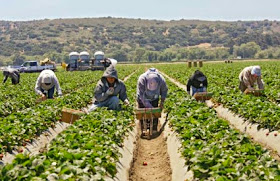California, US, farmers must restrict their use of a tear
gas-like pesticide applied to strawberries and other crops under new rules
designed to protect farmworkers and people who live, work and go to school near
agricultural fields, The Los Angeles Times reports.
The state Department of Pesticide Regulation on Wednesday
announced the nation's strictest limits on chloropicrin, a chemical that many
farmers inject into the soil of strawberries, raspberries, almonds and other valuable
crops.
Hundreds of people have suffered respiratory ailments, skin
irritation and headaches from the pesticide when it has leaked into the air in
recent years, according to agency officials, who say use of the chemical has
been increasing.
While growers complained the restrictions could drive up
costs and the price of produce, health advocates said they do not go far enough
to protect the public from ill effects.
The new rules establish wider buffer zones of up to 100 feet
around fields where the pesticide is applied. Growers will be restricted to fumigating 40 acres a day unless
they use stronger tarps to prevent the
chemical from drifting
away. Growers are also required to give the state 48 hours' notice before
fumigating and to notify surrounding
homes and businesses in Spanish and English.
California produces about 88 percent of the nation's
strawberries, mostly in temperate coastal regions, including Monterey, Santa
Barbara, Santa Cruz and Ventura counties. The population in those areas has
grown, pushing residents and agricultural fields closer together and increasing
health risks from pesticides drifting into neighbourhoods, schools and work
sites, state officials said.
Chloropicrin is "an irritant with characteristics of a
tear gas" that was manufactured as a chemical warfare agent during World
War I, according to the US Centres for Disease Control and Prevention.
Strawberry growers have applied chloropicrin for decades, but its use has
increased in recent years as an alternative to methyl bromide, which is being
phased out under an international treaty.
California growers applied more than 9 million pounds of
chloropicrin in 2012, the most recent year for which data are available.
From 2002 to 2011, 787 people suffered symptoms including
watery eyes, irritated lungs, coughing and headaches as a result of exposure to
chloropicrin gas, state records show. Advocacy groups say the number of
incidents is probably higher because many illnesses are not reported.
State
pesticide regulators began drafting more stringent rules for chloropicrin after
completing a 2010 health review that recommended
reducing the risk of human exposure to the pesticide by limiting its airborne
concentration.
"The
right to farm does not include the right to harm," said Brian Leahy,
director of the Department of Pesticide Regulation.
"Part
of the cost of doing business is putting protective measures in place that
ensure that no one is getting hurt."
Farmworker
and environmental advocacy groups said that the new rules for chloropicrin are
a step in the right direction, but that they fall short of scientists'
recommendations.
"The buffers are not large enough to protect residents,
workers and schoolchildren," said Anne Katten, who monitors pesticide and
worker safety for the California Rural Legal Assistance Foundation.
"The long-term solution is to phase out the use of chloropicrin and other
high-toxicity soil fumigants and move to alternative measures to control soil
pests that are safer and more sustainable."
Industry groups said the rules could raise produce prices.
"California farmers already follow stricter regulations
than farmers in any other state, and these added regulations equal added
costs," including up to US$20 million a year to purchase new tarps, said
Carolyn O'Donnell, spokeswoman for the California Strawberry Commission, a
state government agency that represents the US$2.3-billion industry.
The rules will affect mostly strawberry fields, which are
fumigated each year before planting and account for about 70 percent of all
chloropicrin use, according to the state. The pesticide is also used to protect
raspberries, almonds, peppers, tomatoes and melons against a variety of pests
and diseases.
In a 2012 incident, 15 Ventura County residents and two
fire-fighters reported eye irritation after chloropicrin that was applied on a
strawberry field drifted into the air. More than 300 people in Monterey County
experienced burning and
tearing eyes, nose irritation, coughing and headaches in 2005 when the wind
carried chloropicrin from a field into a residential area.
A report last year by the California Department of Public
Health found that chloropicrin is the agricultural pesticide of health concern
that is applied most heavily within one-quarter of a mile of public schools.
Read the article HERE.
The Global Miller
This blog is maintained by The Global Miller staff and is supported by the magazine GFMT
which is published by Perendale Publishers Limited.
For additional daily news from milling around the world: global-milling.com


No comments:
Post a Comment